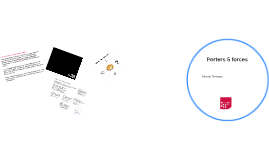PORTERS 5 FORCES
Transcript: ARE WE HAVING FUN? "Easy drinking, Ease of Selection, Sense of fun and adventure." Rivalry: Competition in the aero engine market is dominated by 3 firms. Rolls Royce Case Study RIVALRY YELLOWTAIL WINERIES The number of suppliers is heavily saturated,leaving them with fragmented power. "BOS" CASE STUDY THREAT OF SUBSTITUTES BOS Threat to entry is small, largely due to the complexity of the process. Two on One? That's not fair! ALL SYSTEMS IN SYNC THREAT OF NEW ENTRANTS BLUE OCEAN STRATEGY ALL SYSTEMS ARE GO! REFERENCES A company can use innovation to differentiate itself. The threat of substitutes is minor, with little air travel becoming increasingly popular, Rolls Royce concedes there are some credible threats however. We're lovers not fighters, that's why we're doing are own thing! STRATEGY by Andrew Burke, André van Stel, and Roy Thurik Kim, WCh, Mauborgne, R. 2005c. Value Innovation: A Leap into the Blue Ocean, Journal of Business Strategy 26, 22-28. Kim, WCh, Mauborgne, R. 2005b. Blue Ocean Strategy: From Theory to Practice, California Management Review 47, 105-121. Porter, ME. 1998. Clusters and the New Economics of Competition, Harvard Business Review, 76, 77-90. Porter, ME. 2000. Location, Competition and Economic Development: Local Clusters in a Global Economy, Economic Development Quarterly, 14, 15-34. Websites: http://businesscasestudies.co.uk/rolls-royce/competing-within-a-changing-world/porters-five-forces-model.html#axzz2kI9yODtW http://www.google.com.au/url?sa=t&rct=j&q=&esrc=s&source=web&cd=1&sqi=2&ved=0CCkQFjAA&url=http%3A%2F%2Fblueoceanstrategy.org%2FPresentation.ppt&ei=pSeAUu-BOoXAiQfXp4HoCw&usg=AFQjCNELnOUIppJwMB3YCrp6MDJ4JpPPPg Now we move onto BOS aKa "BLUE OCEAN STRATEGY" PORTERS 5 V BOS PORTERS 5 V BOS??? WHICH TEAM ARE YOU ON?? Yellow Tail eliminated "Oneological terminology and distinctions, Aging qualities, Above the line marketing." SUPPLIER POWER The number of aero engine buyers are low, therefore handing power to the buyers. EVOKE NEW DEMAND ELIMINATING COMPETITION PORTERS 5 BUYER POWER By reducing "Wine complexity, Wine range, Vineyard prestige." Making the competition irrelevant. Entry into the market weakens an already established companies power. Intensity of the competition among existing competitors in the market. This is how much control buyers have to drive down your products price. This is how strong the position of a seller is. SO LETS COMPARE! THANK YOU! Creating the Market PORTERS 5 FORCES CREATE YOUR OWN MARKET Power of Suppliers Threat to Substitutes By creating and differentiating products a company can sets themselves apart from the rest. How easily consumers can switch to competitors products. COMPETITION? WHAT COMPETITION? Power of Buyers Threat of Entry "Price versus Budget Wines, Simplicity of retail store environment, Enthusiasm of Sales People." It is critical that company molds its thinking striving for innovation and a well adjusted cost strategy. EVOKED NEW DEMAND

















